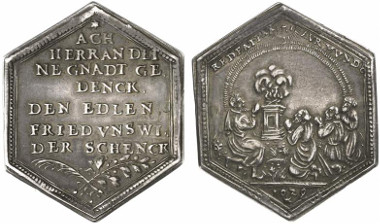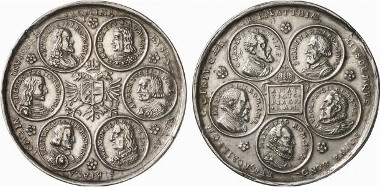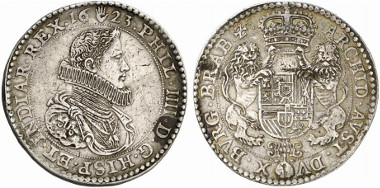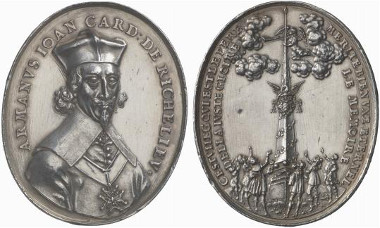Some people refer to the Thirty Years’ War as the great ‘German War’ although technically that term is uncalled for. Spain, France, the Netherlands, Denmark, Sweden, even Poland and England influenced the course of events and made use of Germany as a field of battle. Anyone who limits the Thirty Years’ War to Germany alone will realize that he is missing an essential factor that helps understanding why things were destined to happen just the way they ultimately did.
The campaigns of the Thirty Years’ War were complex ones. Source: P.S. Burton/historicair / http://creativecommons.org/licenses/by-sa/3.0/deed.de
Others refer to the Thirty Years’ War as the last true religious war, but that myth doesn’t bear scrutiny as well. Catholic France allied itself with Protestant Sweden, in order to damage the Catholic House of Habsburg. The Protestant Elector of Saxony supported the Catholic emperor to prevent the Protestant Swedes from invading the German territory of the Holy Roman Empire.
It is, however, impossible to understand what was going on in the Thirty Years’ War without taking the religious aspect into consideration. Emperor Ferdinand II, for example, was firmly convinced that the cause of the Catholics would be promoted when the power of the House of Habsburg was increased. And Gustavus Adolphus was convinced that his mission was to liberate the Protestants albeit he always had Sweden’s advantage in his mind.
Silver medal on the Treaty of Lübeck. Rev.: four men humbly kneeling for prayer in front of an altar. Künker 183 (2011), 2916.
Time and again we see chances for peace wasted because fanatic rulers weren’t willing to distance themselves from religious positions. It was precisely the rulers’ fixation on their mission – whether it was a Catholic one as in the case of Emperor Ferdinand II or the Protestant one with the “mad Halberstadter” – made the Thirty Years’ War become barbarous and the parties involved merciless.
Nobody should hold such a minor incident as the Defenestration of Prague responsible for the outbreak of the Thirty Years’ War. The causes are much more deep-set. For a deeper understanding it is necessary to bring to mind both the agendas and the geographical focal points of the parties involved in the outbreak of the war.
HRE. Matthias, 1608-1612-1619. Silver medal 1613. Medal depicting medallions with eleven emperors. From auction sale Künker 138 (2008), 6014.
The Habsburgs were the most important dynasty during the Thirty Years’ War. They were divided into a western and an eastern branch. In the west, the Spanish king ruled over an empire which not only the territories in the New World were part of but likewise Northern Italy and wealthy Spanish Netherlands.
In the east, the House of Habsburg had established a multinational state surrounding their ancestral homeland Austria and Tyrol to which the Kingdom of Bohemia belonged as well. Things became complicated since, by tradition, a member of the eastern branch of the Habsburg family was Holy Roman emperor to the effect that matters of the empire became intertwined with the machtpolitik of the Duke of Austria and the dynastic interests of the House of Habsburg.
Brabant. Philipp IV of Spain, 1621-1665. Double ducaton 1623, Antwerp. From auction sale Künker 223 (2013), 4.
While the House of Habsburg gained increasingly more power and influence in Austria prior to the Thirty Years’ War, the western branch was already past its best. Although the ships continued to bring gold and silver from the New World, the Spanish Habsburgs had been faced with their power being limited. They could not and did not accept the loss of a part of the Spanish Netherlands during the Dutch War of Independence in particular. The revenues the rich cities generated with trade and commerce were vital for meeting the high expenses, occasioned by the government in Madrid. Thus, the recapture of the ‘rebellious’ provinces took top priority in Spanish politics.
The eastern branch of the Habsburg family considered itself bound to their relatives who were willing to help out in the case of financial problems most of the time. That was the reason why the German emperor made many a political decision over the course of the Thirty Years’ War not in due consideration of its convenience for the imperial policy but for the interests of the Spanish members of the Habsburg dynasty.
Bohemia. Ferdinand II, 1592-1618-1637. 10 ducats 1625, Prague. From auction sale Künker 239 (2013), 5648.
Plus, the leader of the eastern Habsburg branch was Ferdinand II, a fanatically pious Catholic who thought it his duty in world history to undo the repercussions of the reformation. Hence, the aim of Ferdinand can be summarized in three directions: strengthening the position as emperor in order to represent Catholic interest in the empire; strengthening the position as territorial prince in order to recatholicize the people in his own territories; strengthening the position of the House of Habsburg in order to force the Protestant rebels in the Netherlands to become subject to Spanish rule again.
An enemy of Spain by tradition was France, Spain’s neighbor in the Pyrenees. The French king had been defeated in conflicts with Spain far too often. There were conflicts of interests particularly in Northern Italy. The cities there were wealthy, and both the Habsburg family and the Bourbons had a vital interest in their tax revenues. It was only possible for France to defend its own interests when Spain was weak and so the aim of the French policy was, to put it bluntly: all damage to the House of Habsburg was for the good of France.
France. Oval-shaped silver medal n. y. (1642) by S. Dadler on the death of Cardinal de Richelieu. From auction sale Künker 131 (2007), 4069.
Even though the primary rival were the Spanish Habsburgs, the French minister Richelieu directed his hostilities more and more towards the emperor because a powerful member of the Habsburg family as German emperor would support his relatives in Spain. The interests of France most closely corresponded to the ones of the United Netherlands. The ‘rebels’ considered Spain the enemy to be defeated. The Protestant princes in the empire ranked as allies who likewise – albeit at a different front – fought the House of Habsburg that behaved like absolutistic an ruler. Liberty – in terms of politics and religion – was the common goal both of the United Netherlands and the Protestant rulers in the empire.
Of course there were other parties involved that were to play a role in the Thirty Years’ War as well, but it will suffice at this point to bring to mind the positions of Spain, France, the emperor and the United Netherlands in order to understand how such a comparatively minor, local incident like the Defenestration of Prague could have resulted in an international conflict.
In the next part you will read about the Defenestration of Prague and the beginning of the Thirty Years’ War.











